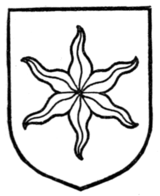the family of Pontifex, and again in that of Thurston, and of Wigan. Its use as a part of a crest is to be deprecated, but in these days of complicated armory it might very advantageously be introduced as a charge upon a shield.
An unusual device, the Thunderbolt, is the crest of Carnegy. The arms of the German family of Donnersperg very appropriately are: "Sable, three thunderbolts or issuing from a chief nebuly argent, in base a mount of three coupeaux of the second." The arms of the town of Blackpool furnish an instance of a thunderbolt in dangerous conjunction with windmill sails.
Stars, a very common charge, may be instanced as borne under that name by the Scottish shield of Alston. There has, owing to their similarity, been much confusion between stars, estoiles, and mullets. The difficulty is increased by the fact that no very definite lines have ever been followed officially. In England stars under that name are practically unknown. When the rays are wavy the charge is termed an estoile, but when they are straight the term mullet is used. That being so, these rules follow: that the estoile is never pierced (and from the accepted method of depicting the estoile this would hardly seem very feasible), and that unless the number of points is specified there will be six (see Fig. 545). Other numbers are quite permissible, but the number of points (more usually in an estoile termed "rays") must be stated. The arm of Hobart, for example, are: "Sable, an estoile of eight rays or, between two flaunches ermine." An estoile of sixteen rays is used by the town of Ilchester, but the arms are not of any authority. Everything with straight points being in England a mullet, it naturally follows that the English practice permits a mullet to be plain (Fig. 546) or pierced (Fig. 547). Mullets are occasionally met with pierced of a colour other than the field they are charged upon. According to the English practice, therefore, the mullet is not represented as pierced unless it is expressly stated to be so. The mullet both in England and



